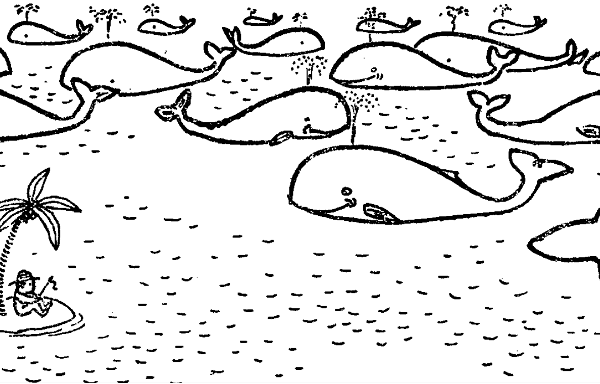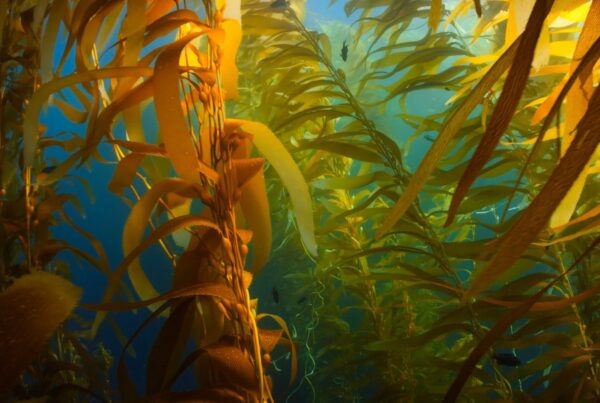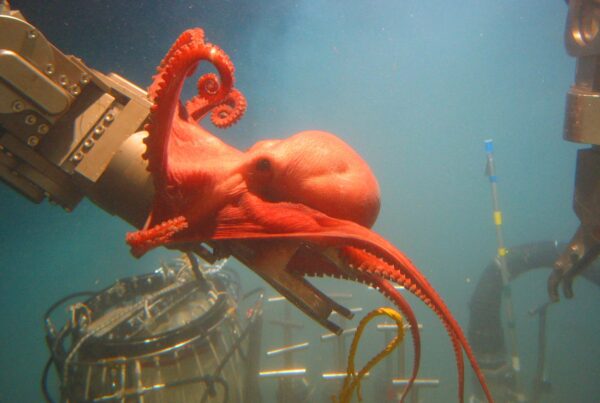Why are some resources[i] sexy and others not? What of the less charismatic resources? What of those small and seemingly insignificant ones – players such as trash fish, sand and sea snails?
Writing about krill, Elizabeth Leane and Steve Nicol at the University of Tasmania note that “size does matter” when it comes to academic and public appreciation of natural resources. As for sand, in his book The World in a Grain, Vince Beiser notes that “sand is the most taken-for-granted natural resource in the world.” And yet, as it is the core ingredient in concrete, in Beiser’s rather over-the-top framing, “the army of sand has fanned out to conquer the entire world.” In an article entitled ‘Drugs from Slugs’ in the very serious journal Chemico-Biological Interactions, Bingham et al. introduce my third player, the Conus snail, as “humble.” John Platt sighs: “Ah, snails. They’re small, they’re slimy. They lack the charisma of a polar bear or a gorilla. And yet…they’re disappearing.”
There are intricacies to celebrate among these unsung entities, but first I need to set the scene of the drama in which they star. They all feature predominantly, though differently, in what is called trophic cascade. ‘Trophic’ refers to the position an entity holds in the system of who eats whom or what. As we may remember from school, the food web consists of the smallest entity on the bottom through to the predators on the top. In marine food webs, this might be visualised as a pyramid with a large base of phytoplankton and algae – often called the primary producers – followed by zooplankton and other herbivorous consumers, the low-level carnivorous consumers such as shellfish, then larger fish, until at the top are the predators such as killer whales.
While picturing this as a pyramid makes the base look very solid, as marine scientist Daniel Pauly and his team have found, we are increasingly “fishing down the food web.” It is well known that when you take out the top carnivores in a marine ecosystem, the entire system gets shaken up.
Entities at the bottom or low levels of the food web are now being targeted for what is called the ‘reduction’ industry. Fish are literally reduced to meal, and their status as important living entities is reduced to nil. Krill, anchovies and sardines are sadly categorised as ‘trash fish.’ They are pulped to feed salmon and the most valuable fish in the world, bluefin tuna, now ‘ranched’ in ocean feedlots.
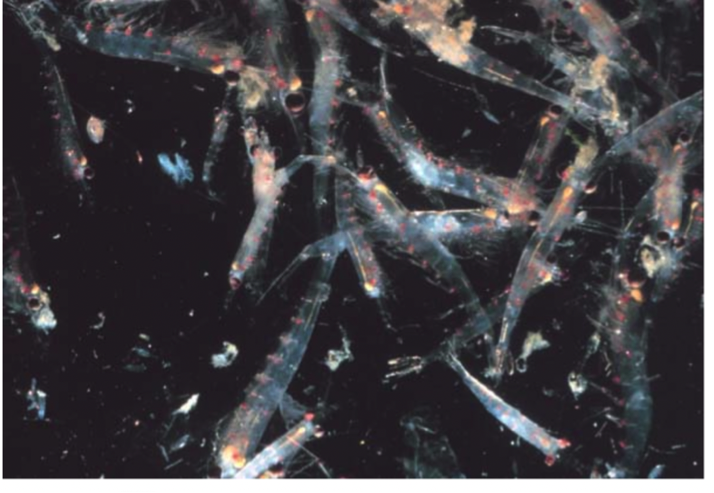
Figure 1: Krill
Krill encapsulate many of the most crucial problems when it comes to the tiny organisms at the bottom – geographically and existentially – of our world. Antarctic krill (Euphausia superba), the one that interests us here, is by far the largest of the krill fisheries in the world, with size estimates fluctuating according to the scientific capacities to count them. People can get very excited about krill, its Latin name meaning “true shining light.” Some say that the word is Norwegian for “young fish,” but Steve Nicol, ‘Dr Krill,’ suggests otherwise: in Norwegian, it is an “onomatopoeia, a word formed to duplicate the sound of millions of krill patterning on the water as they jump clear of the surface.”
Krill plays an essential role as a keystone species in the ecosystems of Antarctica as food for whales, seals, squid, ice fish, penguins, albatrosses and many other species of birds. They are “the only stepping stone in the food chain between one of the tiniest organisms on earth – single-celled diatoms – and the largest creatures of earth – whale.” Krill provide the essential link between phytoplankton and marine mammals. As we’ve seen, phytoplankton is the base of marine ecosystems, responsible for the productivity of the oceans, as they also supply most of the world’s oxygen.
The first commercial krill fishery started in the early 1970s when the Soviet Union started fishing them. Killing krill presents a quandary: they begin to deteriorate very quickly on board, turning black. And they have a very high fluoride content, about the same as the toothpaste on your brush. On the other hand, they are perfect when turned into fish meal for farmed fish, as they naturally possess the red pigment, astaxanthin, that has to be otherwise added artificially so that our farmed salmon and prawns are a luscious reddish colour. Farmed fish on a purely soy, vegetable-based diet would not really count as marine animals – beige entities with none of the omega-3 that has made them so sought after by health-conscious humans.
As the demand and price for krill meal and krill oil have rocketed, so too has the desire to catch and process them. Scientists are divided about the present and future of krill and the Southern Ocean ecosystem that depends on them. Because the fishing grounds are so very far from sight and mind, and because the catch is lucrative, illegal, unreported and unregulated fishing is relatively easy.
I have spent a lot of time at the Sydney Fish Market (SFM) over the years. It is rather decrepit in its present state, bookended by large concrete factories. Owned by the multinational company Hanson, they’ve stood there for over forty years, supplying almost 35 per cent of Sydney CBD’s concrete needs. They are now being moved for the $250 million SFM relocation and revamp supposedly to be finished by 2024.
I was so used to these factories in the background of my mind that it was a shock when I realised that the one on Bridge Road was gone. The new buildings will, of course, be made of concrete. Which is to say that they will be made of sand, as are most of the world’s buildings and roads. One ton of cement requires six to seven tons of sand and gravel. Even during the pandemic, those big, churning concrete trucks kept moving more concrete into the building of apartments.
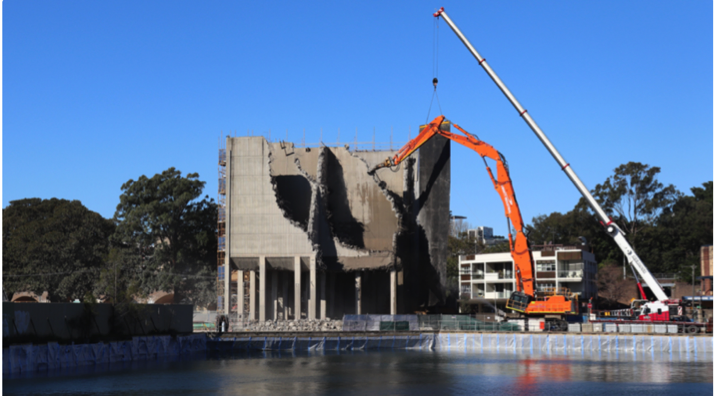
Figure 2: demolition of Hanson concrete factory, Blackwattle Bay, Sydney
Most of us associate sand with beaches. In Australia, we have an embarrassment of choice. It is beach sand that concrete factories want. As one author puts it, ‘exporters in Australia are literally selling sand to Arabs’ to build the tallest buildings and the most elaborate artificial islands in the world in the United Arab Emirates. Desert sand is no good for concrete; it’s too smooth, rounded by wind.
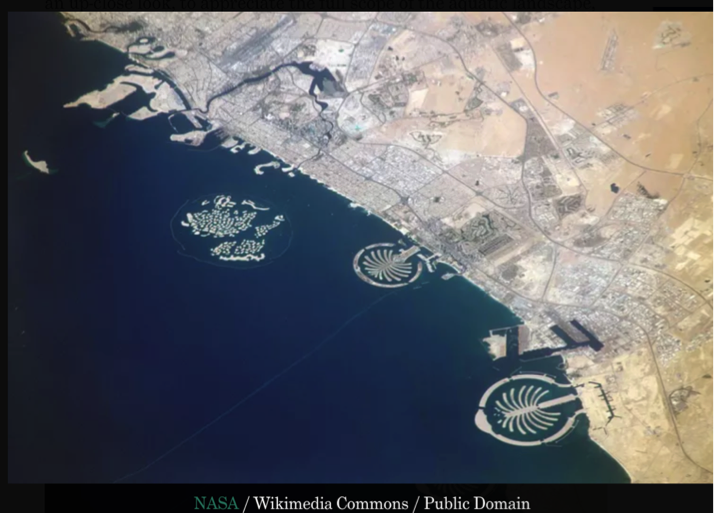
Figure 3: Dubai’s Palm Islands
Sand mining is a huge endeavour. It is also largely illegal. India, for instance, is home to ‘sand mafias,’ and much of Singapore’s reclaimed land is built on and with illegal sand by badly cared for migrant workers. Sand is, by and large, a common pool resource, which is to say it is readily available and hard to regulate. Many now wonder whether we are in the midst of a “looming tragedy of the sand commons.” The effects of sand mining are seen in devastated landscapes, and in the way whole islands disappear seemingly overnight. The removal of sand jolts the ecosystem in a number of ways: dredging mangroves removes essential habitat for fish and other marine organisms, disrupts the balance of sweet and saline water to harm crops and drinking supplies, and creates fetid pools that become breeding grounds for malaria-carrying mosquitos and emerging bacterial diseases.
If we could picture the planet from afar in terms of sand, we would see whole beaches taken from the Global South to ‘rehabilitate’ those in places such as Florida, where beaches are disappearing due to extreme storms and rising sea levels; the levelling of sand dunes in the increasingly frantic search for high-grade mineral sands containing zirconium necessary for the production of glass, electronics and machinery; and the minute figures of men, women and children manually digging and carrying loads of sand while basic dredgers throw it into the air. We’d see the growth of desertification taking over millions of square kilometres in China and elsewhere.
Sand is naturally renewable, but through our actions it simply doesn’t have the time to renew itself, making it a newly scarce resource. The clichés are evident. But even a glimpse into our sandy and sandless world makes me feel that we are standing on shifting ground.
I don’t know that much about cone snails. But what I do know is that Conus are fascinating. There are about 800 or 1,000 different kinds of cone snails in the world, and more than one hundred in Eastern Polynesia – they are hard to count precisely. I am part of a multinational, multidisciplinary team, PolyCone, investigating them. The social science side of the project involves ethnographic fieldwork in French Polynesia.
Cone snails are very beautiful and for centuries have been gathered by shell collectors – and for much longer by Indigenous communities in the South Pacific. One of my colleagues on the project has gathered a compendium of snail images, ‘Cones des marquises’. It is a fitting title for these beautiful specimens, even if it is just the French for the Marquesas Islands – reportedly the most isolated islands in the world. Conus gauguini is named for the artist, with its vibrant reds. Conus imperialis has luscious tawny-brown spots, and Conus magnificus has a stately looking burnished shell. Conus geographus has wonderful whorls that seem to conjure up a whole new geography.
They are predators, divided into groups that eat either worms or fish, and sometimes each other. Because they are slow-moving, over millions of years of evolution they have perfected a killing technique. They have a proboscis, with a harpoon-like tooth, that snares their prey. The mechanism is amazing. That tooth acts like a hypodermic needle, plunging poison into its victim, which the snail then draws into its extended mouth. They can eat fish bigger than themselves, digesting them and spitting out the bones. Conus geographus is the most lethal, and can kill humans in hours. It’s not a nice death: your brain swells, you fall into a coma, and respiratory arrest and heart failure finish you off. There is no antivenom.
It is, however, this amazing ability to kill that is driving research on the conus. Its venom is made of conotoxins, which researchers are describing as a “tool box,” “a pharmacopoeia of biologically active peptides.” These peptides interact with the nervous systems of mammals, including humans, and disrupt the transmission of pain signals. They represent “a whole new class of potent analgesics,” writes David Holmes in The Lancet Neurology. They promise to be “10,000 times more potent than morphine without morphine’s addictive properties and side-effects,” according to National Geographic. In addition to pain treatment, they may also help treat Parkinson’s disease, and even attention-deficit hyperactivity disorder and depression.
There is a ‘but.’ No one has really bothered to discover how these creatures are doing. A recent – and the first – comprehensive overview of the threats to their livelihood points to several factors, including pollution, changes in human habitat and coastal development, and ocean warming.
Bioprospecting could have a huge impact on their numbers, and is potentially very big business. Think of the tragic stories about opiate use. Or the stomach-turning news reports about the Sackler family, who made US$13 billion from their Purdue Pharma’s OxyContin. This synthetic prescription pain reliever is at the heart of the current opiate crisis that is killing hundreds of thousands who overdose. Think of the gazillions of dollars to be made by pharmaceutical companies with a more powerful painkiller that has no addictive side effects.
Our research project obviously doesn’t seek to create more harm. The focus is on developing best access and benefit sharing with the Indigenous Polynesians, and overall the team wants to implement the sustainable extraction of conotoxins. The scientists are consulting about the right choice for collection. This, they hope, will result in a venom bank, with the snails carefully milked for their precious poison. My social scientist colleagues are doing their best to ensure that neither they nor their traditional users will be further harmed. Combined with the marine and biological scientists, perhaps this research could be a smallest drop of change in a massive ocean of hurt.
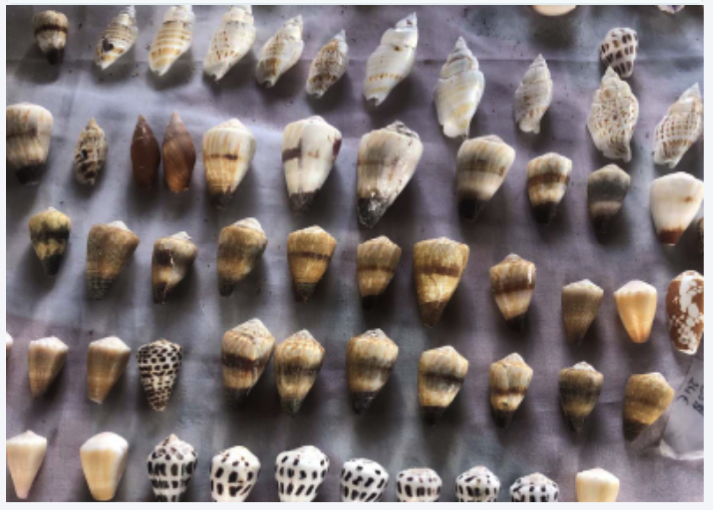
Figure 4: Polynesian cones
I’m interested in the issues that bloom from a consideration of little entities. They are not so uncharismatic as their portrayal in academic research or in the public mind might suggest. Krill, beautiful creatures that swim in the depths of the oceans at the bottom of the world, are big players in our ecosystem in the Southern Ocean. Sure, they won’t attract tourists to Antarctica, a doubtful enterprise at the best of times, but they deserve recognition, and thanks, for keeping alive an ecosystem that supports the flashier species. Their huge cache of protein could be used to feed poorer populations, not just fish for the rich (Probyn).
Grains of sand, so many our human minds can’t fathom, have provided the essential ingredient for our admittedly dumb desire to build over, to build higher, to have easy access to the electronics that grease our way through life. In some ways, they are the saddest of my players – totally overlooked, taken for granted.
And of those gorgeous and, in fact, rather sexy cone snails that beguile with their beauty and fascinate with their wonderful system of killing. Maybe they will deliver relief to those who suffer without turning them into opiate-crazed zombies.
The strands are many, and they mix hope and despair. But these unsung entities matter, big time. Let’s just hope this isn’t a swan song for them.
[i] I realise by so naming these entities I buy into a logic whereby their destiny is as commodities for humans. But they are also resources of hope.
This is an edited version of an essay published in Griffith Review 71 (2021).
Image credits
Figure 1: Krill https://oceanexplorer.noaa.gov/explorations/lewis_clark01/background/midwater_realm/media/krill.html. Image courtesy of Lewis and Clark 2001, NOAA/OER.
Figure 2: Demolition of Hanson concrete factory, Blackwattle Bay, Sydney https://libertyindustrial.com.au/portfolio-item/hanson-blackwattle-bay-batching-plant-demolition/
Figure 3: Dubai’s Palm Islands https://www.treehugger.com/things-massive-enough-to-be-seen-from-space-4869301
Figure 4: Polynesian cones https://apolimer-cnrs.fr/index.php/fr/

